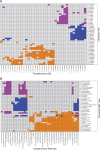Three genetic-environmental networks for human personality
- PMID: 31748689
- PMCID: PMC8550959
- DOI: 10.1038/s41380-019-0579-x
Three genetic-environmental networks for human personality
Abstract
Phylogenetic, developmental, and brain-imaging studies suggest that human personality is the integrated expression of three major systems of learning and memory that regulate (1) associative conditioning, (2) intentionality, and (3) self-awareness. We have uncovered largely disjoint sets of genes regulating these dissociable learning processes in different clusters of people with (1) unregulated temperament profiles (i.e., associatively conditioned habits and emotional reactivity), (2) organized character profiles (i.e., intentional self-control of emotional conflicts and goals), and (3) creative character profiles (i.e., self-aware appraisal of values and theories), respectively. However, little is known about how these temperament and character components of personality are jointly organized and develop in an integrated manner. In three large independent genome-wide association studies from Finland, Germany, and Korea, we used a data-driven machine learning method to uncover joint phenotypic networks of temperament and character and also the genetic networks with which they are associated. We found three clusters of similar numbers of people with distinct combinations of temperament and character profiles. Their associated genetic and environmental networks were largely disjoint, and differentially related to distinct forms of learning and memory. Of the 972 genes that mapped to the three phenotypic networks, 72% were unique to a single network. The findings in the Finnish discovery sample were blindly and independently replicated in samples of Germans and Koreans. We conclude that temperament and character are integrated within three disjoint networks that regulate healthy longevity and dissociable systems of learning and memory by nearly disjoint sets of genetic and environmental influences.
© 2019. The Author(s).
Conflict of interest statement
The authors declare that they have no conflict of interest.
Figures




References
-
- Zohar AH, Zwir I, Wang J, Cloninger CR, Anokhin AP. The development of temperament and character during adolescence: the processes and phases of change. Dev Psychopathol. 2019;31:601–17. - PubMed
-
- Kern ML, Della Porta SS, Friedman HS. Lifelong pathways to longevity: personality, relationships, flourishing, and health. J Pers. 2014;82:472–84. - PubMed
-
- Cloninger CR, Zohar AH. Personality and the perception of health and happiness. J Affect Disord. 2011;128:24–32. - PubMed
-
- Cloninger CR. Feeling good: the science of well-being. New York: Oxford University Press; 2004. p. 374.
Publication types
MeSH terms
LinkOut - more resources
Full Text Sources

